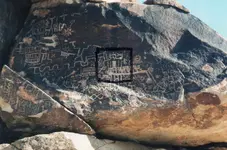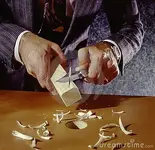Deducer wrote
Putting aside any allegorical interpretation as that constitutes another level of discussion, let's take the statement at face value: Why would the mapmaker (who hopefully was a human being) implicate that that it is he who 'pastures' or 'grazes' north of the river? How would this make sense to the mapreader?
Well the obvious implication (to me) is that it is a priest doing the writing, or we are supposed to think it is a priest.
Deducer also wrote
Do you not agree that most people who look at the horse and then the statement "YO PASTO AL NORTE DEL RIO", conclude that the horse is speaking, based on their experiences that horses are associated with 'pasturing' or 'grazing'?
Certainly, that is the obvious idea being portrayed; however I get the distinct impression that a hidden meaning is supposed to be conveyed, "pasturing" as with the flock of the faithful, and "I am the horse" meaning the priest is the bearer of the holy faith etc.
Deducer also wrote
The carving of a treasure chest is not an abstract design as it has a real-life counterpart. On the other hand, a talking horse, or a 'witch' with no legs speaking of going 18 places, isn't something that exists in life. Why resort to this kind of elaborate symbolism if only a simple money-making scam or hoax? I have not been able to find evidence that Tumlinson engaged in art that was anything else than straightforward depiction, and that in combination with a number of other things, allows me to to dismiss him as the original author of the Stone Maps, with 99% confidence.
Hmm well have to disagree on this; the "witch" may be intended to be a priest, the legs simply hidden from view, so could easily exist in real life. Why assume that this is intended to be
elaborate symbolism, when it could be as simple as it appears? The fact that Travis Tumlinson seems to have had a hobby of making treasure oriented stone carvings and he is the person alleged to have found the stone maps (of which only two are shown on that oldest photo BTW) is
quite a coincidence, wouldn't you agree? I respectfully can't agree about ruling out T. Tumlinson as the maker of the stone maps. In fact Tumlinson family members told Garry Cundiff that Travis had made them. Do you dismiss that so easily?
Deducer also wrote
Yet, what Crazy Jake came up with fell far short of anything that could be remotely considered authentic (in fact Johnson needed to write an entire book to list all the mistakes Jake made), and he ended up in jail. He was apparently not complex or convincing enough to pass muster in court.
You give too little credit to Jake; he was able to successfully fool quite a few prominent local citizens, and getting the conviction was no easy task; he even had compromising photos to help keep potential witnesses from testifying. Quite a study in Crazy Jake, but the point was that a fraud can indeed be quite complex, far from simple and willing to go to some lengths to pull it off. Another example we can point to is the Baron of Arizona Reavis; he traveled to Spain to falsify ancient documents and attempted to sue the USA in court, would you expect that a con man would go to such lengths?
Deducer also wrote
I do not consider the time differences in the discoveries to be of any significance at all.
While the finder of the Stone Maps, Tumlinson had a questionable reputation, the finder of the LH did not, and the find occurred in the same area and separately.
Additionally, the CP paper was found by an individual beyond reproach, a school teacher, and a good friend of Al Reiser, another person also beyond reproach. It additionally was found in a location consistent with, and relevant to the other artifacts that bear the word "Santafe," and so cannot be dismissed. There is also the matter of the symbolism found on it, being consistent with what is on the other artifacts, along with the "misspelled" and gender-incorrect Spanish which also is consistent, and IMHO a very subtle detail that a con man would be unlikely to pick up on.
Hmm again; just as the least trustworthy type of person can be the one who discovers something genuine and important, someone that is utterly trustworthy and above reproach, can be taken in by false evidence. An example in recent history we can point to in Helen Corbin, she (and many other Dutch hunters) were taken in by a sophisticated collection of fraudulent documents and other "evidence" and published it in the belief that it was genuine. Does that make the fakes genuine, that Helen Corbin published them and she is beyond reproach as a source? Or conversely, does it make Helen a fraud, because she was taken in? I would say no in either case.
As to the mis-spelling and incorrect Spanish, another explanation that is just as applicable is that the writer was NOT a Spanish speaker and simply made errors. As with the "coazon" which could very well be an English speaker trying to write the word as it sounded, for the "r" in corazon can be almost undetectable when spoken by a Spanish speaker.
Have to respectfully disagree on the time span between the Peralta stones and the other artifacts being a possible issue. Would you not agree that the finding of one, could inspire a con man to create others of the same ilk?
Why do you conclude that the Cursum Perficio is definitely linked to the Peralta stones? Thank you in advance.
Somehiker wrote
Some would understand the use of such adverbs as a token of humility.
However, the arrogant will only see them as a sign of weakness.
Your statement brings to mind a great quote,
"
The sign of intelligence is that you are constantly wondering. Idiots are always dead sure about every damn thing they are doing in their life. "
— Vasudev.

Good luck and good hunting amigos, I hope you find the treasures that you seek.
Oroblanco










